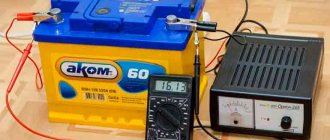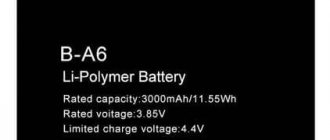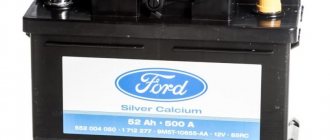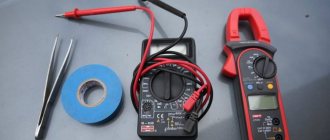17.05.2019
| (No votes) |
Issues discussed in the material:
- How does a car battery work?
- How long does it take to charge a battery at constant current?
- How long does it take to charge a car battery at constant voltage?
- What are the safety rules when charging a battery?
Before use, each battery must be carefully prepared, otherwise you risk encountering a variety of troubles. This device contains dangerous chemicals inside that can harm your car. It is for this reason that it is important to know how long to charge your car battery.
How to set the battery charge level
Determining battery charge
To determine how charged the battery is, take into account its voltage. You can check this characteristic in two ways:
- Carry out the usual measurement of electrical voltage at the battery terminals. To do this, use a digital voltmeter. This device will allow you to show the exact value of the battery voltage level down to tenths and even hundredths of a volt. To measure, the discharge and charging current must be absent for 4-5 hours so that the voltage returns to a normal stable state. There should be a reading between 12.5 and 12.9 volts. Special chargers with a microprocessor and memory are useful. They allow you to more accurately determine the charge level. Such devices are capable of monitoring the discharge and charge of the battery over several cycles.
- The density of the electrolyte is determined, and this parameter is used to determine the degree of charge of the battery. But this option is only suitable for devices with liquid electrolyte.
Timing
How long it takes to charge a 60 Ah car battery can be calculated using a special formula. To measure battery capacity, milliamps per hour or mAh is used. Information about its size is always indicated by manufacturers on the battery case. The charger always contains information about what generates the current of the device. This indicator is expressed in milliamps.
If you divide the battery capacity by the charging current of the charger, you get the time expressed in hours. But you also need to take into account charging efficiency. To determine the time more accurately, the division result should be multiplied by 1.4.
To calculate the time required to charge the battery, use the following formula:
Т=1.4C/I
In it:
- T is the time required to fully charge the battery. It is indicated on the device.
- C is the size of the battery capacity in milliamps per hour.
- I – charging charging current.
When making calculations, it is important to take into account that the time required to charge the battery is affected by its quality, correct formatting, and ambient temperature. This means that real data may differ by 20% from the calculation results.
How many times a day can you charge your phone?
As we have already mentioned, modern Li-ion and Li-po batteries are highly not recommended to be constantly discharged and fully charged. It's much better to keep them half charged (or as close to that as possible).
And if you constantly use your smartphone, then frequent recharging is the only way to preserve the battery for a long time. Of course, you shouldn’t run to the outlet every five minutes as soon as the charge drops by 1-2 percent, because it’s not far from the charging port breaking down) But two or three times a day would be the most optimal solution.
Security measures
Before charging a car battery, you need to properly prepare it:
- First you need to remove condensation, oxide and dirt from the contact surface. To do this, just prepare a soda solution, moisten a rag in it and wipe the upper part - the contacts. Maintaining cleanliness is very important, since if the battery cover is unscrewed from the top, then during dismantling dirt will get inside, which can lead to damage and shorten the service life of the device.
- Open the caps and check the electrolyte level. If it is not enough, then the plates are not closed and distilled water is added. Otherwise, during charging, the lead plates will heat up and crumble. An ideal option would be to measure the density of electrolytes. This indicator, if the battery is normal and in working condition, should be 1.26-1.30 g/cm3.
- Unscrew or pull out the plugs from the battery using a screwdriver. They should be applied to the holes to prevent acid from splashing out. Thanks to this, the gases that will be formed in the process will freely escape.
After preparatory work, charging can be carried out. It is performed using direct current or constant voltage. How long the procedure will take depends on the type.
In order for the car to start again and the battery to remain in its original condition, you need to follow the following precautions:
- Do not charge with a frozen battery. You need to give it time to thaw.
- Monitor the current level. The best option is to use a current of 10% or 0.1 of the battery capacity. For example, if this indicator is 60 Ah, then the charge current should not exceed 6 amperes.
- The procedure can only be carried out in rooms that are well ventilated.
- If the battery is installed, the hood should be kept open during the procedure.
- It is necessary to ensure that the positive pole of the battery is connected to the same one of the charger. The same applies to negative ones.
- The battery should become infected until gas begins to actively form in all cells.
- In summer, the procedure should be carried out as soon as the charge level reaches 50%, and in winter - 25%.
The electrolyte density indicators must be monitored even after charging is complete. If in one cell the density is lower. This indicates that the battery is faulty and will need to be replaced.
At the end, you need to wait 20 minutes until the battery is cleared of gas, then screw it in and insert the plugs into place. It is also recommended to wash and dry the battery. To check whether the housing is passing voltage or not, you need to measure the voltage of the battery cover. If it is below zero, it means it is passing.
Charging time depending on battery type
There are two ways in which you can return the battery to working condition: constant current and constant voltage. The direct current method is used if the battery generator is of a maintenance-free and low-maintenance type. It is important to know how many amperes to supply to the terminals so as not to cause damage to the device.
Maintenance free view
The difference between maintenance-free calcium batteries is that they do not consume water or it is very low. In standard batteries, the decomposition of water into oxygen and hydrogen occurs when the voltage at the terminals reaches 14.4V.
For maintenance-free batteries this period is longer. Therefore, water consumption is significantly lower or almost zero. But this does not mean that such devices do not need recharging. The procedure is carried out in the same way as for other types of batteries and is not difficult even at home.
The need for charging is easy to determine. Most often this is obvious. For example, if the driver forgot to turn off the headlights or music and the battery died. Until the morning, in this case, the entire battery capacity will be depleted and the car will not be able to drive.
Recharging will be required in winter, since during periods of low temperature the stove and heating work and the battery does not restore its charge well. Therefore, maintenance-free devices need to be recharged just as much as other types.
Maintenance-free batteries are different in that they do not have direct access to the electrolyte banks, so they cannot be topped up. It is charged automatically by a constant voltage charger.
The maximum and minimum current levels are set independently as charging progresses.
Initially, using the regulator, a current equal to 1/10 of the capacitance is set. How long you need to charge the battery depends on how low it is. A few hours after the start of the procedure, the set current levels begin to automatically decrease so that the electrolyte does not boil. When it is fully charged, only 220mA will be supplied to the terminals. The battery and the charger connected to it can remain in this form for any period of time without danger.
If a maintenance-free battery is 90% discharged, it fails and cannot be restored to working condition using an automatic charger.
Interestingly, with the help of automatic charging you can recharge not only a maintenance-free battery, but also other types. But you must not allow the battery to drain completely.
Type served
To determine how long it will take to resuscitate such a battery, you need to take into account its features. In order for the procedure to be carried out without danger to the battery, the current should not exceed 10% of the battery capacity.
The boiling of the electrolyte indicates that the battery has received enough energy. On average, it takes about 12 hours for the battery to be fully charged.
To make the process move faster, some car enthusiasts prefer to increase the amperage. But this is not the best option, since high voltage will worsen the condition of the lead plates and significantly reduce the service life of the battery. This approach is especially harmful if the machine runs on a lead-antimony battery.
If the device is deeply discharged, then it is allowed to increase the amperage by no more than 5% of the capacity. The charging voltage should also be reduced within 12-13 volts. Gradually, the current will increase, but you need to ensure that it does not exceed 10% of the capacity, and the voltage level is up to 14.4 V. This is a slow method, since it will take 20 hours for the battery to be fully operational.
Moving the battery to your home
It happens that a driver rarely drives a car in winter. In this case, experienced drivers strongly recommend removing the battery and storing it in a dry, warm room. The recommendation is supported by the fact that a non-working battery at low temperatures quickly deteriorates in its characteristics. Sometimes this even leads to irreversible damage to the battery.
During such storage, it is important not to forget to charge the battery at least once every 3 months. Then he will always be in “combat” readiness.
In conclusion, we emphasize: be attentive to the car and to yourself. Many unpleasant situations will not happen if you think about your safety in advance. Proper use of the battery will allow you to avoid malfunctions. Careful preparation of the car before a long journey will allow you to get to your intended destination without unnecessary incidents.
Happy road!
Charging the battery at constant current
DC battery charge graph
The process consists of several stages, but at each of them it is necessary to maintain a constant current strength, adjust it if necessary and measure the voltage. Therefore, this method is not very convenient. For it you will have to get a charger with adjustable current.
To find out how long a battery charges at constant current, you need to arm yourself with a multimeter and follow these steps:
- At the first stage, the current is set to 0.1 of the rated capacity of the battery. 60 Ah batteries are common in passenger cars. Therefore, they are set to 6 A at a current voltage of 14.4 volts. A multimeter will help you monitor these indicators.
- In the second stage, the voltage will gradually reach 14.4 V and the electrolysis of water will increase sharply. As a result of this process, oxygen and hydrogen are formed. Therefore, the charging current decreases by half or to 3A.
- At the third stage, the voltage level rises to 15V, so the current must be halved further to 1.5 A. It is important to check the voltage once every 2 hours. If it gives the same results, and active gas evolution is observed in the cells, the charge can be stopped.
With this method, it is quite difficult to determine how long it will take to charge the battery. It all depends on the degree of its discharge, age and degree of sulfation. These factors affect how well the battery will accept a charge. Over time, a layer of lead sulfate settles on the surface of the plates, causing the battery capacity to decrease. The lower it is, the faster the battery will become infected.
BONUS RIDDLE!
And now a small bonus related to the topic of this article. Try to guess a rather difficult logic riddle! Answers can be written in the comments (the first three correct answers will receive a like from the site administrator). FORWARD!
How many phones (smartphones) can you charge at the same time?
5 1 Voice
Article rating
Constant voltage charging
Charging the battery at constant voltage
How long a car battery can be charged from a charger also depends on the voltage. Using this method, it is constantly supplied to the battery terminals. The entire charging process will consist of equalizing the voltages at the battery terminals and the terminals of the charger.
This circuit is used if the charger is equipped with an automatic operating mode. The internal resistance of the battery gradually increases and the current decreases. If the current drops to 200mA, the process stops. After this, the battery can be left connected to the charger and when the charge decreases, the device will turn on and recharge it. This is a very convenient home method, since there is no need to control the process; the device will independently regulate charging.
In this case, we can assume approximately how long it will take to charge a car battery, depending on the amount of voltage supplied:
- If it reaches 14.4V, then within 24 hours the 12V battery will be charged to approximately 80%.
- At a voltage of 15V, the device will be charged 90% per day.
- If the voltage level reaches 16 volts, then the car battery will be fully charged.
It is very important to select the proper current level. If this is done incorrectly, the battery can be damaged.
To avoid a decrease in battery performance, manufacturers install protection on chargers, and they themselves reduce the current to a safe value.
Consequences of deep battery discharge and how to properly charge the battery after this
The battery charge may reach zero. In this case, sulfite clogs the plates. This leads to a decrease in capacity. If you need to charge a car battery after a strong discharge, you need to select a voltage of about 16.2V, as well as a current of up to 1A. In this mode, it becomes possible to partially restore the battery plates. Among other things, due to a completely discharged battery, the car alarm may not work, and you will not be able to get inside. By
Fast charging
If it is necessary to turn on the battery urgently, resort to accelerated charging. It helps to quickly restore the battery capacity, but you won’t be able to start the engine for a long time and will have to resort to the usual procedure.
For fast charging, devices have a Boost mode. If you turn it on, an increased level of current begins to flow. Thanks to this, the car battery will be in more or less working condition in 15-20 minutes.
If the charger does not have such a mode, but has a function for adjusting the current, then you can set the increased value yourself. But it is not advisable to choose indicators greater than 30% of the usual current. If this value is exceeded, the condition of the battery plates will deteriorate and the device will quickly fail.
Accelerated charging is not safe for the battery, so it is recommended to use it only in extreme cases, when you urgently need to start the car engine. After the trip, you should fully charge the battery in the required mode.
If you follow all the rules, the charging procedure is not difficult and will not harm the battery. This can be done without special skills and the help of professionals.











